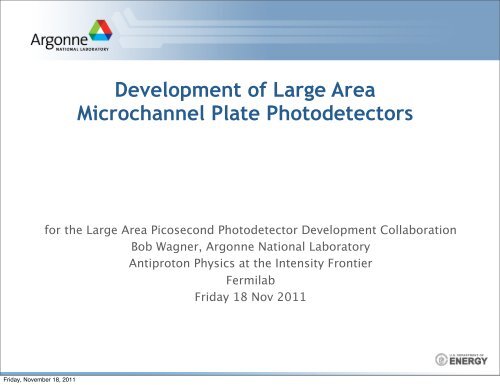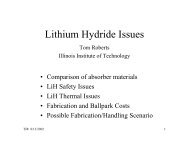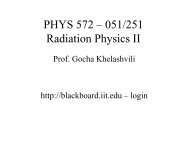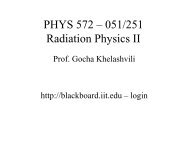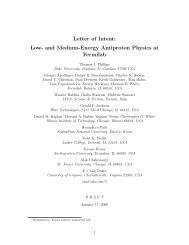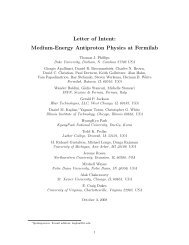Towards Large Area, Picosecond-Level Photodetectors - Capp.iit.edu
Towards Large Area, Picosecond-Level Photodetectors - Capp.iit.edu
Towards Large Area, Picosecond-Level Photodetectors - Capp.iit.edu
Create successful ePaper yourself
Turn your PDF publications into a flip-book with our unique Google optimized e-Paper software.
Friday, November 18, 2011<br />
Development of <strong>Large</strong> <strong>Area</strong><br />
Microchannel Plate <strong>Photodetectors</strong><br />
for the <strong>Large</strong> <strong>Area</strong> <strong>Picosecond</strong> Photodetector Development Collaboration<br />
Bob Wagner, Argonne National Laboratory<br />
Antiproton Physics at the Intensity Frontier<br />
Fermilab<br />
Friday 18 Nov 2011
Microchannel Plate Photomultipliers<br />
!"#$"%#&'()%*$+(,-.//#0(10.2#3(1)43(<br />
Incoming Particle<br />
or Photon<br />
Photocathode Multichannel Plates Anode (stripline) structure<br />
<strong>Towards</strong> <strong>Large</strong> <strong>Area</strong> MCP <strong>Photodetectors</strong>, R. Wagner, Argonne, Antiproton Physics Workshop, Fermilab, 20111118<br />
Front-End Electronics<br />
Vacuum Assembly<br />
Multiple plates to increase gain<br />
Chevron<br />
!"#$#%&'%(&)*)+$,#%&-'$".&',)&."#,$&&/)0&11&$#&12+,#%.&0"2+"&,).3*$.&2%&/'.$4&&<br />
arrangement to inhibit positive ion freeback to photocathode<br />
3%2/#,1&!*'%',&5)#1)$,64&&.+'*'7*)&$#&*',5)&',)'.&<br />
Friday, November 18, 2011<br />
Typical pore size is 6-40µm<br />
2
MCP-PMT Module & Readout Concept<br />
2×3 array of MCP Tiles<br />
for paneling detector, e.g.<br />
water Cherenkov tank<br />
Friday, November 18, 2011<br />
<strong>Towards</strong> <strong>Large</strong> <strong>Area</strong> MCP <strong>Photodetectors</strong>, R. Wagner, Argonne, Antiproton Physics Workshop, Fermilab, 20111118<br />
Strip readout pattern<br />
3.8mm strips, 5mm pitch (40 strip anode)<br />
4.6mm strips, 6.8mm pitch (30 strip anode)<br />
Coordinate readout:<br />
• Time difference along strip<br />
• Charge division for ⊥ direction<br />
3
LAPPD Project Scope<br />
<strong>Large</strong>, Cheap, Fast Microchannel Plate Photomultiplier<br />
‣ 20×20 cm 2 active area (development on 3.3cm diam. disk)<br />
‣ Novel, inexpensive MCP substrate<br />
• Borofloat glass capillary substrates (20-40μm pores, L/D ∼60-40)<br />
• Anodic aluminum oxide (AAO) (research ended) -- ceramic<br />
‣ Pore activation via Atomic Layer Deposition (ALD)<br />
• Separate material for resistive and secondary emission layers<br />
• Optimize resistive and emissive layers via study of range of materials<br />
‣ Customized anode readout<br />
• Strip line double-ended readout for picosecond timing & water Cherenkov<br />
• Pad readout for energy and/or coarse spatial resolution -- gamma-ray<br />
telescope camera, dual readout calorimeters, medical imaging<br />
‣ High quantum efficiency photocathode --- ≥25%<br />
• Bialkali (baseline), multialkali<br />
• “III-V” materials, e.g. GaAs, GaN<br />
• Systematic program of photocathode development and analysis<br />
‣ Waveform sampling switched capacitor array ASIC for readout<br />
‣ Use simulation to vet and tune design<br />
Friday, November 18, 2011<br />
<strong>Towards</strong> <strong>Large</strong> <strong>Area</strong> MCP <strong>Photodetectors</strong>, R. Wagner, Argonne, Antiproton Physics Workshop, Fermilab, 20111118<br />
5
Glass Capillary Substrate Development<br />
Borosilicate glass capillary substrates from<br />
Incom, Inc. (Charlton, MA, USA)<br />
Technology development on 32.8mm<br />
diameter disk substrates<br />
– 20μm (L/D=60) & 40μm (L/D=40)<br />
pore size<br />
20cm × 20cm plates for working detector<br />
(18) 40μm pore substrates delivered<br />
(35) 20μm pore substrates delivered<br />
Baseline is 20μm pore<br />
All substrate pores have 8˚ bias w.r.t axis<br />
⊥ to substrate<br />
Used in pair chevron configuration to<br />
r<strong>edu</strong>ce positive ion feedback damage<br />
to photocathode<br />
Friday, November 18, 2011<br />
substrate detail 2010<br />
photo credit: Jason McPhate, SSL<br />
<strong>Towards</strong> <strong>Large</strong> <strong>Area</strong> MCP <strong>Photodetectors</strong>, R. Wagner, Argonne, Antiproton Physics Workshop, Fermilab, 20111118<br />
20cm × 20 cm glass<br />
substrates October, 2011<br />
photo credit: Joe Gregar, Argonne<br />
substrate detail<br />
August, 2011<br />
6
Advances in Glass Capillary Array Development<br />
1st Batch vs. Present Batch 20µm pores<br />
Multifiber stacking<br />
evident<br />
Triple point gaps<br />
Pore crushing at<br />
multifiber boundaries<br />
Triple point gaps<br />
eliminated<br />
Minimal pore<br />
distortion<br />
Still some stacking<br />
issues<br />
Friday, November 18, 2011<br />
>?@A-"* 82 "B8"(
F>;00'@%$!"&FE';&5'0">"#%&'D;@)$'($%#)00"&F'?)#-&%>%F")0A''7"F=$)'G'"0';'@>%D#-;$?'?-;?'5)!%&0?$;?)0';<br />
%.)$.")D'%@'?-"0'($%#)5=$)A''H&'%$5)$'?%'($%5=#)';&'*+,E'%&)'&))50'?%'#$);?)'?-)';(($%($";?)'C=">5"&F<br />
@))5'?-)'($%#)00A'B-)$)@%$)E'%=$')@@%$?'C)F;&'CJ'!)>?"&F'&)D'F>;00'!;?)$";>0'($"%$'?%'0?;$?"&F';&J'@"C)$'5<br />
#>;55"&F'6?=C):'!;?)$";>'"0';'($%($")?;$J'F>;00'5).)>%()5'CJ'KLMNO'"&?)$&;>>J'6I&%D&';0'N%&F'N"@) '*<br />
;&5' ?-)' #%$)' 6$%5:' C;$' "0' ;' (-J0"#;>>J' #%!(;?"C>)' F>;00' ?-;?' -;0' C))&' 5)0"F&)5' ?%' C)' #-)!"#;>>J' =&0<br />
?-)$)@%$)'.)$J'0%>=C>)'"&';#"5A'''<br />
Commercial Microchannel Plate Fabrication<br />
Glass is gravity-fed via<br />
cylindrical furnace<br />
Glass is typically lead glass<br />
tube with solid soft glass core<br />
Borosilicate glass capillaries<br />
are hollow core<br />
Chemical processing to<br />
remove soft core glass<br />
hollow core glass capillaries<br />
skip this step<br />
Friday, November 18, 2011<br />
[>;00 *%&%@"C)$ \$;D<br />
[>;00 *=>?"@"C)$ \$;D<br />
K">>)?'7;C$"#;?"%&<br />
K">>)?'U>"#)E'[$"&5E',%>"0-<br />
+-)!"#;>',$%#)00"&F'<br />
ALD replaces<br />
this step<br />
Before sealing in tube, plate must be<br />
subjected to prolonged exposure to electrons<br />
A'234567#8##)/:63;9#2?=@#/A96;00)0';$)'?-)&'5$;D&'"&?%'!%&%@"C)$0A''P&#)'?-)'!%&%@"C)$0'-;.)'C))&'@;C$"#;?)5<br />
8<br />
;00)!C>)5' "&?%' ;' -)Q;F%&;>' ;$$;J' ;&5' $)5$;D&' "&?%' !=>?"R@"C)$0A' H?' "0' ?-)0)' !=>?"R@"C)$0' ?-;?' ;$)' =0)5<br />
C%=>)' %$' C">>)?A' ' B-"0' C=&5>)' "0' @=0)5' ;&5' "0' ?-)&' $);5J' @%$' 0>"#"&FE' F$"&5"&F' ;&5' (%>"0-"&F' !=#-' >"I)' ;<br />
<strong>Towards</strong> <strong>Large</strong> <strong>Area</strong> MCP <strong>Photodetectors</strong>, R. Wagner, Argonne, Antiproton Physics Workshop, Fermilab, 20111118<br />
Graphic Credit: B. Laprade & R. Starcher, Burle (2001)<br />
9J5$%F)&'M)5=#?"%&<br />
O>)#?$%5)'O.;(%$;?"%&<br />
7"&;>'B)0?'Z'H&0()#?"%&
!"#$%&'&()*+&,-.$/-)+01$234&5$<br />
Pore Activation via Atomic Layer Deposition<br />
%&*)60-0),$<br />
/5;),,&9$/553D03,1&$<br />
%&*)60-0),$<br />
/5;),,&9$/553D03,1&$<br />
A A conformal, self-limiting process.<br />
Allows Allows atomic level level thickness control.<br />
Conformal, self-limiting process<br />
Molecular mono-layer thickness control<br />
<strong>Large</strong> variety of applicable materials<br />
Applicable Applicable for for a large large variety of of materials.<br />
<strong>Towards</strong> <strong>Large</strong> <strong>Area</strong> MCP <strong>Photodetectors</strong>, R. Wagner, Argonne, Antiproton Physics Workshop, Fermilab, 20111118<br />
!7$8(3+9$/7$!3,&9$:7$#&,;9$2.8?%@A8#B9$$<br />
>7$?C((0'3,$=/553D03,1&B9$/7$7$?C((0'3,$=/553D03,1&B9$/7$
Pore Activation via Atomic Layer Deposition (ALD)<br />
Example:<br />
• OH on surface provide reaction sites<br />
• Trimethyl aluminum reacts liberating<br />
methane, forms Al2O3 layer. Leaves methyl<br />
group inhibiting further reaction on surface<br />
• Exposure to H2O removes methyl group.<br />
Leaves OH sites for next reaction<br />
pore<br />
Friday, November 18, 2011<br />
pore<br />
Resistive ALD<br />
OH OH OH<br />
Al<br />
CHAl 3CH3<br />
Al<br />
OH OH OH<br />
CH3 <strong>Towards</strong> <strong>Large</strong> <strong>Area</strong> MCP <strong>Photodetectors</strong>, R. Wagner, Argonne, Antiproton Physics Workshop, Fermilab, 20111118<br />
pore<br />
Emissive ALD<br />
CH3 CH3 1 KV<br />
CH 3<br />
Al<br />
CH3 Trimethyl Aluminum<br />
Al<br />
(TMA) O O O<br />
CH CH3 3<br />
pore<br />
Al(CH 3 ) 3<br />
H 2 O<br />
Conductive<br />
Electrode<br />
OH<br />
Al Al<br />
OH OH OH<br />
OH OH<br />
10
ALD Functionalization of Micro-Channel Plates<br />
New ALD chemistries for resistive coating developed at Argonne<br />
Friday, November 18, 2011<br />
Resistance is reproducibly tunable<br />
βT = -0.02 for commercial MCP (literature)<br />
= -0.027 “New Chemistry 1”<br />
<strong>Towards</strong> <strong>Large</strong> <strong>Area</strong> MCP <strong>Photodetectors</strong>, R. Wagner, Argonne, Antiproton Physics Workshop, Fermilab, 20111118<br />
Al2O3 Secondary Emission Layer<br />
Signal from MCP pair coated with new<br />
resistive layer + Al2O3 emissive layer<br />
image credit: M. Wetstein<br />
11
Secondary Emissive Materials Characterization<br />
Characterization Chamber<br />
• UV Photoelectron Spectrometer<br />
• X-ray Photoelectron Spectrometer<br />
• Low Energy Electron Diffraction<br />
Friday, November 18, 2011<br />
<strong>Towards</strong> <strong>Large</strong> <strong>Area</strong> MCP <strong>Photodetectors</strong>, R. Wagner, Argonne, Antiproton Physics Workshop, Fermilab, 20111118<br />
12
Electroding - End Spoiling<br />
h = b/d<br />
End-spoiling on output<br />
‣ Increases spatial resolution<br />
‣ Decreases gain<br />
‣ Trade-off h = 1-2<br />
End-spoiling on input ~ h = 0.5-0.8<br />
b<br />
Electroding system for 8”×8” MCPs nearing<br />
completion<br />
Friday, November 18, 2011<br />
<strong>Towards</strong> <strong>Large</strong> <strong>Area</strong> MCP <strong>Photodetectors</strong>, R. Wagner, Argonne, Antiproton Physics Workshop, Fermilab, 20111118<br />
Electroding system at<br />
Fermilab for 33mm MCPs<br />
Line-of-sight evaporation<br />
13
MCP Testing at Argonne -- APS UV Laser Facility<br />
Gap 1: “first strike”<br />
Impacts on variability of<br />
transit time and<br />
amplification<br />
Gap 2: Impact on saturation<br />
of MCP pair, spatial spread<br />
of signal<br />
Gap 3:spatial and temporal<br />
spreading of the charge<br />
cloud. Space charge effects.<br />
Interface with anode.<br />
Friday, November 18, 2011<br />
<strong>Towards</strong> <strong>Large</strong> <strong>Area</strong> MCP <strong>Photodetectors</strong>, R. Wagner, Argonne, Antiproton Physics Workshop, Fermilab, 20111118<br />
Operational voltages<br />
Plate geometry (pore size,<br />
L/D)<br />
Chemistry (SEE, resistive<br />
layer)<br />
Plate quality<br />
Uniformity<br />
Noise<br />
Stability<br />
Plate resistance<br />
Saturation<br />
Relaxation time<br />
14
MCP Testing at Argonne -- APS UV Laser Facility<br />
Gap 1: “first strike”<br />
Impacts on variability of<br />
transit time and<br />
amplification<br />
Gap 2: Impact on saturation<br />
of MCP pair, spatial spread<br />
of signal<br />
Gap 3:spatial and temporal<br />
spreading of the charge<br />
cloud. Space charge effects.<br />
Interface with anode.<br />
Friday, November 18, 2011<br />
<strong>Towards</strong> <strong>Large</strong> <strong>Area</strong> MCP <strong>Photodetectors</strong>, R. Wagner, Argonne, Antiproton Physics Workshop, Fermilab, 20111118<br />
Operational voltages<br />
Plate geometry (pore size,<br />
L/D)<br />
Chemistry (SEE, resistive<br />
layer)<br />
Plate quality<br />
Uniformity<br />
Noise<br />
Stability<br />
Plate resistance<br />
Saturation<br />
Relaxation time<br />
14
MCP Testing at Argonne -- “Mock Tile” MCPs<br />
Friday, November 18, 2011<br />
Eight 33mm MCP disks functionalized with identical<br />
“Chemistry 2” resistive coating and Al2O3 SEE layer<br />
<strong>Towards</strong> <strong>Large</strong> <strong>Area</strong> MCP <strong>Photodetectors</strong>, R. Wagner, Argonne, Antiproton Physics Workshop, Fermilab, 20111118<br />
15
Commissioning of 8” Test Chamber at Argonne APS<br />
4<br />
8” MCP Vacuum Test Assembly<br />
Friday, November 18, 2011<br />
8” Tile base with<br />
Tuesday Meeting, 8-9-11<br />
33mm MCP pair<br />
Tuesday, August 9, 2011<br />
ready for insertion<br />
into chamber<br />
<strong>Towards</strong> <strong>Large</strong> <strong>Area</strong> MCP <strong>Photodetectors</strong>, R. Wagner, Argonne, Antiproton Physics Workshop, Fermilab, 20111118<br />
Tuesday Meeting, 8-9-11<br />
Tuesday, August 9, 2011<br />
16<br />
9
First Pulse Measurements with 8” Anode Strip Line<br />
!"#$%&'()*$$+,)*-$$+,)*-$<br />
Adjacent Strip<br />
Adjacent Strip<br />
Friday, November 18, 2011<br />
5 ns<br />
30 mV<br />
Signal<br />
Crosstalk<br />
!"#$%&'()*$$%&'()*$$+,)*-$<br />
Crosstalk<br />
<strong>Towards</strong> <strong>Large</strong> <strong>Area</strong> MCP <strong>Photodetectors</strong>, R. Wagner, Argonne, Antiproton Physics Workshop, Fermilab, 20111118<br />
!"#$%&'()*$$+,)*-$$+,)*-$<br />
25 mV<br />
Signal<br />
Signal<br />
Crosstalk<br />
17<br />
S
Meeting, 9-27-11<br />
mber 27, 2011<br />
First Pulses on 20cm × 20cm MCP Plate<br />
Friday, November 18, 2011<br />
Signal from ends of strip line<br />
Laser timing signal<br />
Tuesday Meeting, 9-27-11<br />
Simple soldered wire connection to strip 4 line<br />
Readout and differential timing with fast scope<br />
<strong>Towards</strong> <strong>Large</strong> <strong>Area</strong> MCP <strong>Photodetectors</strong>, R. Wagner, Argonne, Antiproton Physics Workshop, Fermilab, 20111118<br />
45<br />
40<br />
35<br />
30<br />
25<br />
20<br />
15<br />
10<br />
Tuesday, September 27, 2011<br />
5<br />
differential arrival time distribution<br />
0<br />
1.5 1 0.5 0 0.5 1 1.5<br />
500 ps<br />
18<br />
x 10 9
MCP Testing at Space Sciences Lab (SSL)/Berkeley<br />
25mm Phosphor on<br />
4.5” CF Flange<br />
25mm Cross Strip Delay<br />
Line photon counting<br />
detector on 4.5” CF Flange<br />
Single MCP Phosphor Image Pair MCP XDL Image<br />
Friday, November 18, 2011<br />
<strong>Towards</strong> <strong>Large</strong> <strong>Area</strong> MCP <strong>Photodetectors</strong>, R. Wagner, Argonne, Antiproton Physics Workshop, Fermilab, 20111118<br />
Double Chamber UHV Test Station<br />
Amp/TDC and PC Acq/display<br />
for XDL<br />
Nikon camera or electrometer<br />
for Phosphor<br />
19
Improvement in Glass Capillary Array Fabrication<br />
1 MCP, Phosphor readout<br />
2 MCPs, Photon counting<br />
Friday, November 18, 2011<br />
Early 2010 July 2011<br />
UV 184nm illumination<br />
<strong>Towards</strong> <strong>Large</strong> <strong>Area</strong> MCP <strong>Photodetectors</strong>, R. Wagner, Argonne, Antiproton Physics Workshop, Fermilab, 20111118<br />
• 20 µm MCP, L/D = 60, 8˚ pore bias,<br />
1000V applied to each MCP<br />
• Imaging & gain comparable to<br />
commercial MCPs<br />
• Sample performance shows dramatic<br />
improvement due to capillary<br />
process improvements<br />
20
Argonne ALD MCP Pair Background Test<br />
!"#$#%&'#(%$)%*&+,-*)%*&.)$"&/'!&!-)01&<br />
MCP pair, 20µm pores, 8° bias, 60:1 L/d, 0.7mm gap with 300V bias<br />
GHI#8>%4,#6,#T=U;#-V+,##="W((#8>%4#'>8#F%E7#X==C#M%>6"###<br />
.(>'?#;@A*(#BC#D%'7E,#673F6#E38#GHI#7&J#<br />
(3+)D>E%3*#K67>48L#>*+#?>%*E##GHI#7&J>'3*>D#<br />
(3+)D>E%3*#?43(#M3EE3(#GHI"#N#?&F#+&?&OE6,#<br />
185nm UV illumination. Top MCP hex<br />
M)E#'&*&4>DDP#:&4P#'33+"#Q+'&#&??&OE6#>4&#?%&D+#<br />
modulation (sharp) and faint bottom MCP<br />
?4%*'%*'#+)&#E3#E7&#GHI#6)8834E#?D>*'&"#<br />
modulation<br />
Friday, November 18, 2011<br />
X===#6&O#M>O5'43)*+,#="=@YA#&:&*E6#O( Z< #<br />
6&OZ; #>E#W#J#;= T #'>%*,#;=A=:#M%>6#3*#&>O7#<br />
GHI"#/&E#6>(&#M&7>:%34#?34#(36E#3?#E7&#<br />
O)44&*E#
Robustness<br />
MCP 162, 2 nd Batch MCPs, 20µm<br />
Breakdown event with a phosphor screen which essentially<br />
evaporated away the electrode on a part of MCP162.<br />
Inspection showed no melting of the pores.<br />
Electroded on top of the damaged face and tested in phosphor detector – no sign of damage!<br />
Any regular MCP would have been toast – melted!!!<br />
Friday, November 18, 2011<br />
<strong>Towards</strong> <strong>Large</strong> <strong>Area</strong> MCP <strong>Photodetectors</strong>, R. Wagner, Argonne, Antiproton Physics Workshop, Fermilab, 20111118<br />
22
!!""#$%&'()*#*+,-./0121./1/3#4,525#<br />
33mm ALD MCP Pre-Conditioning Tests<br />
Friday, November 18, 2011<br />
?H@))(#JX=SF#AH5&3)V#U%V7#Y/C#(3*%V34%*'#B%46V,#V7&*#>?#BW33+#W3U#'H%*,#V7&*#<br />
<br />
#JOCT"##E36V#4&@&*V#C-D#B34()WHV%3*PK#<br />
!"#$%#$&'(")()%*+%,-.%/0'#$1%*"2(3%%"45('%-%6%&789 %:$;+%4(
Hermetic Packaging<br />
‣ For working MCP Photodetector, need to provide<br />
• Functionalized, Scrubbed MCP Plates<br />
• Vacuum tight housing<br />
- Bottom plate with anode strip lines<br />
- Sidewall<br />
- Top plate with photocathode<br />
- Getter strip for long term pumping<br />
• Support/Spacers to separate<br />
MCPs, bottom/top plates<br />
MCP - 1<br />
MCP - 2<br />
Anode on Base plate<br />
Ceramic body:<br />
Expensive, brazed ⇒ proven in smaller designs<br />
HV & Signal via pins thru body<br />
SSL Design<br />
Friday, November 18, 2011<br />
<strong>Towards</strong> <strong>Large</strong> <strong>Area</strong> MCP <strong>Photodetectors</strong>, R. Wagner, Argonne, Antiproton Physics Workshop, Fermilab, 20111118<br />
Borosilicate all glass design:<br />
Frugal, innovative ⇒ higher risk<br />
No pin penetration into housing<br />
Under development at Argonne<br />
Window with Photocathode inside<br />
HV Distribution pattern<br />
Grid Spacer – Type A<br />
Getter Strip<br />
Grid Spacer – Type B<br />
Grid Spacer – Type C<br />
Side wall<br />
Getter Bead<br />
24
Demountable 8” Tile Prototype<br />
Leak checking of assembled<br />
demountable structure<br />
Friday, November 18, 2011<br />
<strong>Towards</strong> <strong>Large</strong> <strong>Area</strong> MCP <strong>Photodetectors</strong>, R. Wagner, Argonne, Antiproton Physics Workshop, Fermilab, 20111118<br />
Inner, outer retainer<br />
rings for demountable<br />
O-ring seal<br />
Inner, outer retainer<br />
rings for demountable<br />
O-ring seal<br />
25<br />
O
Photocathode Fabrication -- SSL<br />
B33, B33+ITO, B33+MgO/ITO substrates<br />
Substrates with ITO are very bad, ITO-MgO better, but not great<br />
Friday, November 18, 2011<br />
Cathode test run #6B, Na 2 KSb cathode, Sb<br />
<strong>Towards</strong> <strong>Large</strong> <strong>Area</strong> MCP <strong>Photodetectors</strong>, R. Wagner, Argonne, Antiproton Physics Workshop, Fermilab, 20111118<br />
26
8.7” Photocathode & Seal Test Chamber<br />
8.7” Photocathode/Seal Test Chamber<br />
Friday, November 18, 2011<br />
Ion Pump<br />
Lines<br />
16.5” Flange<br />
Chamber Access<br />
Forming<br />
Well of 6”<br />
<strong>Towards</strong> <strong>Large</strong> <strong>Area</strong> MCP <strong>Photodetectors</strong>, R. Wagner, Argonne, Antiproton Physics Workshop, Fermilab, 20111118<br />
Same All-<br />
Metal Valves<br />
Same Rough<br />
Pump Line<br />
27
<strong>Large</strong> Process Chamber for Ceramic Tube Fabrication<br />
at SSL<br />
Vacuum Chamber 18”<br />
O.D x 30” Long<br />
14” Access Tube<br />
Detector Body Stack<br />
on 16.5” CF Flange<br />
Friday, November 18, 2011<br />
Multiple Viewports<br />
Multi- Motion<br />
Manipulator Arms<br />
All-Metal Valves to<br />
Three Pumping Ports<br />
8” P-C Forming Well Tube<br />
Two UHV Ion<br />
Pumps<br />
<strong>Towards</strong> <strong>Large</strong> <strong>Area</strong> MCP <strong>Photodetectors</strong>, R. Wagner, Argonne, Antiproton Physics Workshop, Fermilab, 20111118<br />
28
Bialkali Photocathode Development at Argonne<br />
‣ Shoot photocathode<br />
similar to traditional<br />
PMT method<br />
• metal beads activated<br />
by current heating<br />
‣ Use glass containment<br />
vessel with bead<br />
support structure &<br />
detachable top window<br />
‣ Learn method by<br />
making photocathodes<br />
on small PMTs<br />
• PMT processing<br />
equipment obtained<br />
from Burle Industries<br />
Friday, November 18, 2011<br />
<strong>Towards</strong> <strong>Large</strong> <strong>Area</strong> MCP <strong>Photodetectors</strong>, R. Wagner, Argonne, Antiproton Physics Workshop, Fermilab, 20111118<br />
29
Results from Photocathode Growth in Burle Process<br />
Chamber<br />
/01,23,45356722,89&$'&:,;?@
!"#$%&'%()"*+(,%+--,#%.$#/($/#,%"-0%<br />
to o-ring;<br />
Bialkali Photocathode -- Scale-Up to 4” Photocathode<br />
Friday, November 18, 2011<br />
)+1)%$,23,#"$/#,%45%6)2%(&"7%<br />
("8*,<br />
Chalice Mounted To The Burle System<br />
• Began pumping on empty chalice body last Thursday;<br />
• Performed bake-out Friday and Monday. Limited bake-out temperature to 200 C due<br />
to o-ring;<br />
• Pressure: 1!10 -7 Torr this morning. Reached 8!10 -8 Torr yesterday morning;<br />
<strong>Towards</strong> <strong>Large</strong> <strong>Area</strong> MCP <strong>Photodetectors</strong>, R. Wagner, Argonne, Antiproton Physics Workshop, Fermilab, 20111118<br />
• Pressure: 1!10 -7 Torr this morning. Reached 8!1<br />
Vacuum<br />
pump port<br />
Connector pins<br />
Vacuum<br />
pump port<br />
Glass top plate<br />
O-ring seal<br />
Support stand<br />
31<br />
C
Summary<br />
‣ <strong>Large</strong> <strong>Area</strong> Microchannel Plate Photodetector project has completed 2 nd year<br />
‣ Many critical milestones achieved for detector realization<br />
• Signals acquired from full-sized tile base with 33mm MCP pair in 8” test ch.<br />
• ALD coatings of 33mm glass capillary disks producing gain >10 6 for MCP pair<br />
• Observation of gain from 8”×8” MCP<br />
• Production of detector quality 8”×8” glass capillary arrays<br />
• Developed 3 ALD resistive + 2 ALD emissive chemistries<br />
• Low temperature (120˚C) In(52)Sn(48) seal made on 1” sidewall/window<br />
• Readout ASIC for picosecond resolution fabricated & tested (4 th gen. chip due in<br />
October)<br />
‣ Mature mechanical designs for hermetically sealed tube<br />
• Proven design in ceramic by SSL<br />
• Well-advanced inexpensive glass design -- hermetic prototypes<br />
‣ Facility for 8”×8” photocathode fabrication and study near completion at SSL<br />
• Full-size process chamber installed, near commissioning<br />
‣ Tile production facility for All-Glass MCP-PMT in design at Argonne<br />
Friday, November 18, 2011<br />
Visit our web site for more information:<br />
http://psec.uchicago.<strong>edu</strong><br />
(“Blog” and “Library” links are a good starting place)<br />
<strong>Towards</strong> <strong>Large</strong> <strong>Area</strong> MCP <strong>Photodetectors</strong>, R. Wagner, Argonne, Antiproton Physics Workshop, Fermilab, 20111118<br />
32
Friday, November 18, 2011<br />
BACKUP SLIDES<br />
<strong>Towards</strong> <strong>Large</strong> <strong>Area</strong> MCP <strong>Photodetectors</strong>, R. Wagner, Argonne, Antiproton Physics Workshop, Fermilab, 20111118<br />
33
Anodic Aluminum Oxide (AAO) Development<br />
‣ Self-ordering fabrication of pore structure<br />
in aluminum by anodization<br />
‣ Alternative to glass capillary MCP<br />
‣ Argonne AAO fabrication is 2-step<br />
• Form 10nm pore matrix through<br />
anodization (more “natural” size for<br />
process)<br />
• Pattern and etch 2-10μm pore via<br />
photolithography<br />
- Initial 10nm pore structure enables uniform etch<br />
larger diameter pores<br />
‣ Development at Argonne is very successful<br />
• Now producing pores with funneled pores<br />
Friday, November 18, 2011<br />
- Potential for large effective open area ratio<br />
- Addresses first-strike problem<br />
- Possible future generation of MCP with<br />
Photocathode coated on funnel via ALD<br />
<br />
<br />
10μm pore<br />
<strong>Towards</strong> <strong>Large</strong> <strong>Area</strong> MCP <strong>Photodetectors</strong>, R. Wagner, Argonne, Antiproton Physics Workshop, Fermilab, 20111118<br />
<br />
40μm spacing<br />
1 st testable AAO based MCP at Argo<br />
SEM (Scanning Electron Microscope)<br />
Front<br />
5μm funnel<br />
"#$$%&%$'()$*%<br />
32.8mm AAO test substrate<br />
20µm pore, L/D~10, 23% open area<br />
34<br />
!
Scale-up to <strong>Large</strong> Surface <strong>Area</strong><br />
Process scale-up test: ALD chemistry #2<br />
Process scale-up on large reactor<br />
est: ALD chemistry #2<br />
!"#$#%$&"'()*%$+,'-.)("##'%"#%"/'<br />
)+'(0#%)1'1*/"'2*.,"'#03#%.*%"'<br />
-.)("##$+,'456'."*(%). <br />
"#%"/'<br />
#%.*%"'<br />
!"#$%&'(()*'+),-'.%/00,-.1<br />
45566%7-%8)90+<br />
300mm Si wafer coated with Chemistry #2 23<br />
:;25;
Scale-Up of ALD Processing -- Beneq Reactor<br />
Arrived 18 May 2010<br />
Studying ALD on<br />
<strong>Large</strong> Surface <strong>Area</strong>s<br />
• 33mm disk surface area<br />
is 0.13m 2<br />
• 8”x8” surface area is<br />
6.4m 2<br />
• 20 MCPs area is 129m 2<br />
Development of <strong>Large</strong> <strong>Area</strong> Fast MCP <strong>Photodetectors</strong>, R. Wagner, Argonne, DOE Site Visit, 20100825<br />
Development of Lower Cost <strong>Large</strong> <strong>Area</strong> MCP Photodetector, R. Wagner, Argonne, LIGHT11, Ringberg Castle, 20111101<br />
Wednesday, August 25, 2010<br />
Friday, November 18, 2011<br />
Tray top Tray Bottom<br />
8”x8” tile<br />
Stackable 20cm × 20cm plate<br />
holders for multiple plate coating<br />
in Beneq Reactor<br />
8”x8” tile<br />
500 mm<br />
10 trays<br />
8<br />
36
8”×8” MCP Plate Testing at SSL<br />
ALD Coated 8”×8” 20µm MCPs<br />
1 st production quality plates (Apr, 2011)<br />
Develop process for Resistive Coating<br />
Tuning parameters now for ALD coating in<br />
Beneq reactor<br />
Friday, November 18, 2011<br />
8” electroded MCP in the open face test detector.<br />
MCP #3 and MCP #2 have been electroded on both sides with 1700Å inconel.<br />
#2 is 31kΩ and #3 is 3MΩ in air - and vacuum (Needs to be ~10-30MΩ).<br />
<strong>Towards</strong> <strong>Large</strong> <strong>Area</strong> MCP <strong>Photodetectors</strong>, R. Wagner, Argonne, Antiproton Physics Workshop, Fermilab, 20111118<br />
37
Visual Study of ALD Coated MCP at SSL<br />
Glass capillaries coated by<br />
Arradiance, Inc.<br />
Pair test at Space Sciences<br />
Lab/UC-Berkeley<br />
Electron map of MCP<br />
“Multi” boundaries visible,<br />
fade at higher gain<br />
Friday, November 18, 2011<br />
<strong>Towards</strong> <strong>Large</strong> <strong>Area</strong> MCP <strong>Photodetectors</strong>, R. Wagner, Argonne, Antiproton Physics Workshop, Fermilab, 20111118<br />
38
Mock Tile Fabrication<br />
‣ Short-cut to testing full assembled<br />
large area MCP-PMT<br />
‣ Glass 8”×8” Mock MCP w/4 holes<br />
for 33mm functional MCP pairs<br />
‣ Use tile bases with pump-out port<br />
on sidewall & standard anode<br />
bottom plate<br />
‣ Top window with Al photocathode<br />
‣ Top seal with glass frit (like<br />
bottom seal)<br />
Friday, November 18, 2011<br />
First successful sealed box<br />
with two scrap 8”×8” MCPs<br />
<strong>Towards</strong> <strong>Large</strong> <strong>Area</strong> MCP <strong>Photodetectors</strong>, R. Wagner, Argonne, Antiproton Physics Workshop, Fermilab, 20111118<br />
39
Mock Tile Fabrication -- Tile Base<br />
Apply Frit Paste to Sidewall 350˚C Fire to Dry Paste 470˚C Fire to Glaze<br />
Attach Getter Holders<br />
Silver Ink Frit @ 350˚C<br />
Friday, November 18, 2011<br />
470˚C Fire to<br />
Bond Anode Plate<br />
<strong>Towards</strong> <strong>Large</strong> <strong>Area</strong> MCP <strong>Photodetectors</strong>, R. Wagner, Argonne, Antiproton Physics Workshop, Fermilab, 20111118<br />
Completed Tile Base<br />
w/Vacuum Tight Bond<br />
40
Anode<br />
Ceramic Body Design -- SSL<br />
Vacuum-side<br />
Air-side pinout<br />
Graphic courtesy of Jason McPhate, SSL<br />
Getter Stack<br />
Friday, November 18, 2011<br />
<strong>Towards</strong> <strong>Large</strong> <strong>Area</strong> MCP <strong>Photodetectors</strong>, R. Wagner, Argonne, Antiproton Physics Workshop, Fermilab, 20111118<br />
• Single step braze<br />
–Stamped OFHC Cu or Kovar indium<br />
well<br />
–Kovar intermediary flange<br />
–Alumina wall<br />
–Kovar getter flange<br />
–HiTemp, CuSil brazed anode<br />
• InCuSil braze alloy (750°C<br />
braze)<br />
–Avoids remelt of anode CuSil<br />
• Four braze joints in final<br />
assembly<br />
Illustrative Tube Stack<br />
41
Opaque GaN Deposited on 33mm ALD MCP<br />
>3436%?%@AB&CD-E#FGH#@3AB&+#IJ#F>K#L%B7#HM+38&+#/A9CD?9#3N#:A4%3)6#B7%@5*&66&6<br />
OA(34873)6C83?J@4J6BA??%*&P#A*+#B&6B&+#%*#A#873B3*#@3)*B%*'#%(A'%*'#+&B&@B34#<br />
.*B&'4AB&+#873B3*#@3)*B%*'#%(A'&##<br />
)6%*'#;QR#*(#ST#673L6#)*843@&66&+#<br />
/A9#?AJ&4#4&683*6&#:6#IA4&#FGH"#<br />
Friday, November 18, 2011<br />
!"#$%&'(#)'*&"+,-.&/'+0'12*'345,'<br />
;"VU#<br />
="
General proc<strong>edu</strong>res for Fabrication of MCPs<br />
Pristine<br />
MCPs<br />
4 hrs<br />
Electrode<br />
coating<br />
Testing<br />
resistance<br />
3 hrs<br />
courtesy Qing Peng, Argonne ALD Group<br />
Friday, November 18, 2011<br />
30mins 2 hrs<br />
Acetone<br />
sonication clean<br />
Baking at 400C<br />
under N2<br />
6 hrs<br />
Deliver for testing<br />
Air dry at<br />
200C >2h<br />
ALD coatings<br />
10 hrs<br />
Loading in<br />
Vacuum reactor<br />
2 hrs<br />
Ozone clean<br />
For fabricating one pair<br />
MCPs:<br />
~20-30hrs<br />
if everything is right


